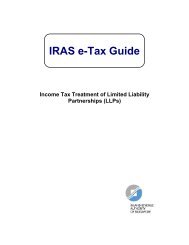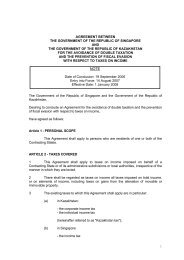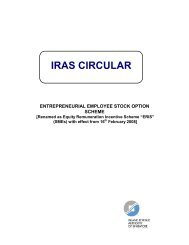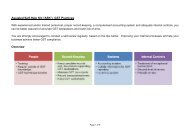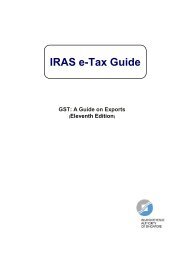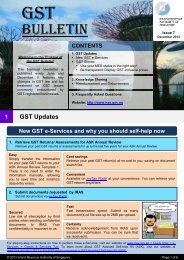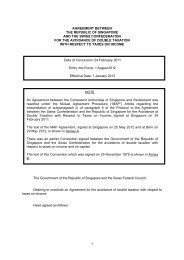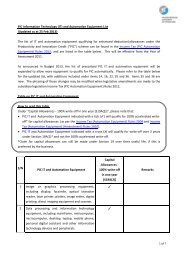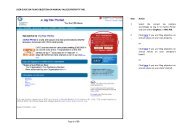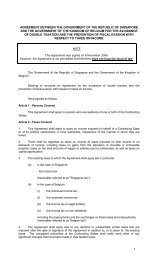Equity Remuneration Incentive Scheme (Start-Ups) - IRAS
Equity Remuneration Incentive Scheme (Start-Ups) - IRAS
Equity Remuneration Incentive Scheme (Start-Ups) - IRAS
You also want an ePaper? Increase the reach of your titles
YUMPU automatically turns print PDFs into web optimized ePapers that Google loves.
<strong>IRAS</strong> CIRCULAR<br />
EQUITY REMUNERATION INCENTIVE<br />
SCHEME (START-UPS)<br />
1
Published by<br />
Inland Revenue Authority of Singapore<br />
Published on 1 August 2008<br />
© 2008 <strong>IRAS</strong> Singapore. All Rights Reserved<br />
No part of this publication may be<br />
reproduced or transmitted in any form or by<br />
any means, including photocopying and<br />
recording without the written permission of<br />
the copyright holder, application for which<br />
should be addressed to the publisher. Such<br />
written permission must also be obtained<br />
before any part of this publication is stored<br />
in a retrieval system of any nature.<br />
2
EQUITY REMUNERATION INCENTIVE SCHEME (START-UPS)<br />
INTRODUCTION<br />
1. Gains derived by an individual from employee stock option (hereinafter<br />
referred to as “ESOP”) plans and employee share ownership (hereinafter referred to<br />
as “ESOW 1 ”) plans granted in respect of Singapore employment are assessable to<br />
income tax. These gains are taxed as income of the individual for the year in which<br />
the options are exercised, the shares are granted or vested, or the moratorium on the<br />
disposal of the shares is lifted, as the case may be.<br />
2. Over the years, a number of tax measures have been implemented to<br />
enhance the tax treatment of gains derived from ESOP or ESOW plans. These<br />
measures include the Qualified Employee <strong>Equity</strong>-Based <strong>Remuneration</strong> (QEEBR)<br />
<strong>Scheme</strong> 2 , Entrepreneurial Employee <strong>Equity</strong>-based <strong>Remuneration</strong> (EEEBR) <strong>Scheme</strong> 3<br />
and Company Employee <strong>Equity</strong>-based <strong>Remuneration</strong> (CEEBR) <strong>Scheme</strong> 4 .<br />
3. To improve the attractiveness of equity-based compensation tools for new<br />
start-up companies the Minister for Finance announced in his Budget Statement<br />
2008 5 a new <strong>Equity</strong> <strong>Remuneration</strong> <strong>Incentive</strong> <strong>Scheme</strong> (<strong>Start</strong>-<strong>Ups</strong>) (ERIS (<strong>Start</strong>-<strong>Ups</strong>)).<br />
Under the ERIS (<strong>Start</strong>-<strong>Ups</strong>), an employee of a qualifying company can enjoy a tax<br />
exemption of 75% of up to $10 million of gains from ESOP or ESOW plans over a 10-<br />
year period, provided certain criteria are met.<br />
4. This circular provides details of the ERIS (<strong>Start</strong>-<strong>Ups</strong>).<br />
1 Generally, ESOW plans allow employees of a company to own or purchase shares in the company or that of its parent<br />
company. They include share awards and other similar forms of employee share purchase plans, but exclude phantom shares and<br />
share appreciation rights (SARs) which merely use share prices as a basis for computing the amount of benefits to be paid to the<br />
employees.<br />
2 QEEBR <strong>Scheme</strong> was introduced to alleviate cash flow problems faced by employees who do not sell their shares after acquiring<br />
them, or exercising their stock options. The <strong>Scheme</strong> allows employees to defer payment of tax on gains from ESOP or ESOW<br />
plans for up to 5 years, subject to an interest charge at prime rate. For details, please refer to <strong>IRAS</strong>’ press statement issued on 25<br />
October 1999 on the “Qualified Employee Stock Option Plan <strong>Scheme</strong>”.<br />
3 EEEBR <strong>Scheme</strong>, given as an incentive to encourage technopreneurship, allows an employee of a company to enjoy a tax<br />
exemption of 50% of up to $10 million of gains from ESOP or ESOW plans arising over a period of 10 years, provided certain<br />
conditions are met. For details, please refer to <strong>IRAS</strong>’ Circular dated 22 May 2000 on “Entrepreneurial Employee Stock Option<br />
<strong>Scheme</strong>” (now renamed as ERIS (SMEs)), <strong>IRAS</strong>’ Circular dated 27 December 2002 on “Changes to Tax Treatment of Employee<br />
Stock Options and Other Forms of Employee Share Ownership Plans (Revised Edition)”, and section 13J of the Income Tax Act<br />
(ITA).<br />
4 .Under the CEEBR <strong>Scheme</strong>, for each year, an employee of a company can enjoy tax exemptions on gains from ESOP or ESOW<br />
plans of up to $1 million arising over a period of 10 years if certain criteria are met. The employee will enjoy a full tax exemption<br />
on the first $2,000 worth of gains from the ESOP or ESOW plan and a tax exemption of 25% on the remaining amount of gains<br />
from the said ESOP or ESOW plan. This <strong>Scheme</strong> is to encourage more established companies which do not qualify for the<br />
exemption under the EEEBR <strong>Scheme</strong> to grant ESOP or ESOW plans to employees at all levels. For details, please refer to <strong>IRAS</strong>’<br />
Circular dated 31 March 2001 on “Company Stock Option <strong>Scheme</strong>” (now renamed as ERIS (All Corporations) ), <strong>IRAS</strong>’ Circular<br />
dated 27 December 2002 on “Changes to Tax Treatment of Employee Stock Options and Other Forms of Employee Share<br />
Ownership Plans (Revised Edition)”, and section 13L of the ITA.<br />
5 Following the Budget announcement, the existing EEEBR and CEEBR <strong>Scheme</strong>s will now be re-named under one umbrella<br />
scheme called the <strong>Equity</strong> <strong>Remuneration</strong> <strong>Incentive</strong> <strong>Scheme</strong> (hereinafter referred to as “ERIS”). The ERIS will henceforth be<br />
made up of three tiers. The first two tiers comprise the existing EEEBR <strong>Scheme</strong> (now known as the ERIS (SMEs)) and the<br />
CEEBR <strong>Scheme</strong> (now known as the ERIS (All- Corporations)), while the third tier, is the ERIS (<strong>Start</strong>-<strong>Ups</strong>)).<br />
3
ERIS (START-UPs)<br />
Effective Date<br />
5. The ERIS (<strong>Start</strong>-<strong>Ups</strong>) is available to tranches of stock options or shares<br />
granted under an ERIS (<strong>Start</strong>-<strong>Ups</strong>) Plan during the period from 16 February 2008 to<br />
15 February 2013 (both dates inclusive). A qualifying company has to grant the<br />
options or shares within the first 3 years of its incorporation, to a qualifying employee<br />
to acquire ordinary shares of the qualifying company.<br />
6. ESOP plans granting stock options to an employee to acquire redeemable<br />
shares, convertible shares or shares of a preferential nature or ESOW plans<br />
awarding such shares to the employee are excluded from the ERIS (<strong>Start</strong>-<strong>Ups</strong>).<br />
Similarly, stock options or share awards granted under a Group ESOP or ESOW<br />
Plan operated by the parent company of the qualifying company are also excluded<br />
from the ERIS (<strong>Start</strong>-<strong>Ups</strong>). The ERIS (<strong>Start</strong>-<strong>Ups</strong>) will be subject to review after 5<br />
years.<br />
QUALIFYING CRITERIA<br />
ERIS (<strong>Start</strong>-<strong>Ups</strong>) Plan<br />
7. An ESOP plan will qualify as an ERIS (<strong>Start</strong>-<strong>Ups</strong>) Plan if it meets the vesting<br />
period requirement as prescribed by the Singapore Exchange (SGX) for companies<br />
listed on the SGX, regardless of whether the company is listed on the SGX or not.<br />
8. For ease of reference, the current SGX’s rules on vesting periods for ESOP<br />
Plans of companies listed on the SGX are reproduced below:<br />
(a)<br />
(b)<br />
where the exercise price of the option to acquire shares is equivalent<br />
to or exceeds the market value of the shares at the time of grant of<br />
option, the option given on the shares may not be exercised within 1<br />
year from the grant of the option;<br />
where the exercise price of the option to acquire shares is at a<br />
discount to the market value of the shares at the time of grant of<br />
option, the option given on the shares may not be exercised within 2<br />
years from the grant of the option.<br />
9. ESOP plans of companies not listed on the SGX must also satisfy the above<br />
vesting period requirement in order to qualify to be an ERIS (<strong>Start</strong>-<strong>Ups</strong>) Plan. In the<br />
case of unlisted companies where the market value of their shares is not readily<br />
available to determine which vesting period shall apply, the net asset value of the<br />
shares is to be used instead.<br />
10. If SGX changes the above vesting period rules, companies would have to<br />
ensure that their ESOP plans comply with the amended rules from the date the<br />
change in rules takes effect in order for the ESOP plans to continue to qualify to be<br />
ERIS (<strong>Start</strong>-<strong>Ups</strong>) Plans.<br />
11. The market value mentioned in paragraph 8 above refers to the market value<br />
of the shares at the time the option is granted. For a company listed on the SGX,<br />
4
the SGX rules on ESOPs provide that the market value is the average market price<br />
prevailing during the price fixing period immediately before the options are granted.<br />
The price fixing period is explicitly defined for each stock option scheme in the<br />
company circular to the shareholders, which informs them of the proposed motion to<br />
approve the stock option scheme. The computation of the average market price is<br />
decided by the company and is also stated in the same circular. Consequently, in<br />
the case of an SGX listed company, if the exercise price were fixed at or exceeds the<br />
average market price prevailing during the price fixing period, a one-year vesting<br />
period would apply for the purposes of the ERIS (<strong>Start</strong>-<strong>Ups</strong>) Plan. If, however, it were<br />
fixed at a discount to the average market price, the vesting period would be two<br />
years for the purposes of the ERIS (<strong>Start</strong>-<strong>Ups</strong>) Plan.<br />
12. An ESOW plan must meet the minimum holding period 6 before it can qualify<br />
as ERIS (<strong>Start</strong>-<strong>Ups</strong>) Plan. The minimum holding period is as follows:<br />
(a) where the price payable by an employee to acquire a share is equivalent<br />
to or exceeds the market value of the shares at the time of the grant of the<br />
share under the ESOW plan, a moratorium of at least ½ a year must be<br />
imposed i.e. the share so acquired cannot be disposed of by that<br />
employee within ½ year from the date of grant.<br />
(b) where the price payable by an employee to acquire a share is at a<br />
discount to the market value of the share at the time of the grant of the<br />
share under the ESOW plan, a moratorium of at least 1 year must be<br />
imposed i.e. the share so acquired cannot be disposed of by that<br />
employee within 1 year from the date of grant.<br />
13. Companies do not have to apply for approval from Comptroller of Income Tax<br />
(referred hereafter as “the Comptroller”) to have their ESOP or ESOW plans<br />
considered as ERIS (<strong>Start</strong>-<strong>Ups</strong>) Plans. However, companies that wish to operate<br />
ERIS (<strong>Start</strong>-<strong>Ups</strong>) Plans have to keep sufficient documentation to show, when<br />
required by the Comptroller, that their ESOP or ESOW plans satisfy the required<br />
vesting period or minimum holding period as the case may be. In addition, they are<br />
required to comply with the administrative requirements as set out in paragraphs 32<br />
to 36 of this circular.<br />
Qualifying company<br />
14. A qualifying company is any company that grants options under ESOP plans<br />
or shares under ESOW plans operated by the company 7 , to its employees within the<br />
first 3 years of its incorporation. The company must meet the following requirements<br />
at the time of grant of options or shares:<br />
(a) it is a company incorporated in Singapore;<br />
(b) it must carry on business activities in Singapore;<br />
6 Please refer to paragraph 21 of <strong>IRAS</strong>’ Circular dated 27 December 2002) on “Changes to Tax Treatment of Employee Stock<br />
Options and Other Forms of Employee Share Ownership Plans (Revised Edition)”.<br />
7<br />
Under ERIS (<strong>Start</strong>-<strong>Ups</strong>), a parent company which grants stock options under a group ESOP plan or shares under a group<br />
ESOW plan to an employee of another company within its corporate group does not qualify as a qualifying company in relation<br />
to the employee.<br />
5
(c) it has a total share capital which is beneficially held directly by no more<br />
than 20 shareholders –<br />
i. all of whom are individuals; or<br />
ii.<br />
at least one of whom is an individual holding at least 10% of<br />
the total number of issued ordinary shares of the qualifying<br />
company; and<br />
(d) the aggregate market value of its gross assets at the time of grant of the<br />
options or shares (or if this is not available, the aggregate market value of<br />
its gross assets as reflected in its audited accounts at the end of the<br />
accounting period immediately before the grant of the options or shares),<br />
does not exceed $100m. Where the market value of any asset is not<br />
available, its book value as reflected in the audited accounts may be used<br />
instead.<br />
15. “Gross assets”, in relation to a company, means the total assets of the<br />
company including any tangible assets, intangible assets (e.g. goodwill, patents) or<br />
capitalized expenses (e.g. plant and machinery) as reflected in the company’s<br />
accounts, net of any provisions made such as the provision for depreciation of fixed<br />
assets, amortization of intangible assets and capitalized expense, provision for<br />
doubtful debts and diminution in value of assets. The example in Annex 1 illustrates<br />
how the aggregate market value of gross assets of a company is determined.<br />
16 The audited accounts used to determine whether or not a company has met<br />
the aggregate gross asset value requirement must not be subject to a qualified<br />
opinion by the company’s external auditor.<br />
17. In the absence of audited accounts or where the relevant audited accounts<br />
have been subject to a qualified external auditor’s opinion, a company may still be a<br />
qualifying company if it can provide a certificate from its external auditor confirming<br />
that the aggregate market value of gross assets of the company as at the date of<br />
grant of stock options or end of the relevant accounting period, as the case may be,<br />
to be not more than $100 million.<br />
Qualifying Employees<br />
18. A qualifying employee has the same meaning as that under the ERIS (SMEs)<br />
(previously known as EEEBR). That is, he is an employee who has been granted<br />
stock options under an ESOP plan, or shares under an ESOW plan by a qualifying<br />
company and also meets the following requirements at the time of the grant of<br />
options or shares:<br />
(a) he is exercising employment for the qualifying company;<br />
(b) his committed working time per week with the qualifying company<br />
must be at least 30 hours; and<br />
(c) he does not have effective control of the qualifying company.<br />
19. Where an employee’s committed working time with a qualifying company is<br />
less than 30 hours per week at the time of the grant of options or shares, he can<br />
nevertheless qualify as a qualifying employee if at the time, his committed working<br />
6
time per week with that company amounts to at least 75% of his total working time<br />
per week. In such a case, the employee is required to make a declaration to the<br />
qualifying company on his total working time per week at the time of the grant of<br />
options or shares to enable the company to determine whether the 75% test has<br />
been met. In the absence of such a declaration to the company, the employee<br />
cannot be considered as a qualifying employee under the ERIS (<strong>Start</strong>-<strong>Ups</strong>). The<br />
examples in Annex 2 illustrate how this rule will be applied.<br />
20. For the purposes of ERIS (<strong>Start</strong>-<strong>Ups</strong>):<br />
(a) a non-executive director of a company is not regarded as an<br />
employee of the company;<br />
(b) “committed working time”, in relation to an employee, means the total<br />
time the employee is officially required to spend on the business of his<br />
employer (excluding overtime and lunch time). Basically, this includes<br />
any time he would have been officially required to spend on the<br />
business of his employer but for:<br />
i. injury, ill-health or disability;<br />
ii. maternity or paternity leave;<br />
iii. leave entitlement;<br />
iv. paid training or study leave;<br />
v. not being required to work during a period of notice of<br />
termination of employment;<br />
(c ) “total working time” means the total committed working time as an<br />
employee for all employers plus, where applicable, the total time spent<br />
on remunerative work as a self-employed person;<br />
(d) in subparagraph (c), if an employee is also a self-employed person,<br />
the “total time spent on remunerative work as a self-employed person”<br />
shall be deemed to be 10 hours per week.<br />
21. An employee is considered as having effective control of a company if he<br />
beneficially owns, directly or indirectly, voting shares that give him the right to<br />
exercise, or control the exercise of not less than 25% of voting power in the<br />
company. For most qualifying companies, the determination of whether or not an<br />
employee has effective control of the company based on this rule should not pose<br />
any problem. However, in some cases where a company is unable to determine<br />
definitively whether an employee has effective control of the company due to reasons<br />
such as the use of nominees, it can require the employee to provide a declaration on<br />
his beneficial ownership, directly or indirectly, of voting shares in the company. In<br />
such cases, if the employee does not give the requisite declaration to the company,<br />
he cannot be considered as a qualifying employee under the ERIS (<strong>Start</strong>-<strong>Ups</strong>).<br />
7
COMPUTATION OF TAXABLE GAINS FROM ESOP OR ESOW PLAN<br />
UNDER THE ERIS (START- UPS)<br />
22. Like ERIS (SMEs) and ERIS (All Corporations) the ERIS (<strong>Start</strong>-<strong>Ups</strong>) does<br />
not change the current basis of determining when gains from ESOP or ESOW plan<br />
accrue to an employee and the amount, as provided in section 10(6) of the ITA.<br />
23. Gains from an ESOP or ESOW plan accrue to an employee at the time the<br />
options are exercised, the shares are granted or vested, or when the moratorium on<br />
the disposal of shares is lifted, as the case may be. The amount of taxable gains is<br />
determined based on the difference between the market value or net asset value of<br />
the shares, as the case may be, and the exercise price (in the case of options) or the<br />
price paid/payable (in the case of share awards) to acquire the shares. Under the<br />
ERIS (<strong>Start</strong>-<strong>Ups</strong>), 75% of the gains of up to $10 million from options or shares<br />
granted within the first 3 years of incorporation of the qualifying company accruing to<br />
an employee will, subject to paragraph 25, be exempt from tax, over a period of 10<br />
years commencing from the year the employee first enjoys the partial tax exemption<br />
on his gains from ESOP or ESOW plan.<br />
24. To illustrate, if an employee exercises his stock options (granted by the<br />
qualifying company during its 1 st year of incorporation, say on 1 March 2008) in 2009<br />
and makes a gain of $1 million, 75% or $750,000 of the gain will be exempt from tax.<br />
Over the next 9 years (i.e. years 2010 to 2018), he can enjoy 75% tax exemption on<br />
further ESOP gains of up to $9m. The example in Annex 3 illustrates the application<br />
of the 75% tax exemption.<br />
25. Where discounted stock options or share awards (i.e. where the exercise<br />
price is lower than the market value or net asset value of the underlying shares at the<br />
time of grant) are granted by a qualifying company to a qualifying employee under an<br />
ERIS (<strong>Start</strong>-<strong>Ups</strong>) Plan, the 75% tax exemption will only be applicable to the ESOP<br />
gains less the amount of the discount enjoyed. Correspondingly, the discounts are<br />
excluded from the $10 million exempt income threshold as mentioned in paragraph<br />
23 above.<br />
26. For tranches of options or shares under ESOP or ESOW plans granted by the<br />
qualifying company after its first 3 years of incorporation, the employee may enjoy<br />
the tax exemption accorded under the ERIS (SMEs) on his ESOP or ESOW gains<br />
arising from the exercise of options or vesting of shares of up to another $10 million<br />
over another 10 years, provided the terms and conditions for ERIS (SMEs) are met.<br />
OPTIONS OR SHARES THAT CONCURRENTLY MEET CONDITIONS<br />
UNDER THE ERIS (START-UPS), ERIS (SMES) AND ERIS (ALL<br />
CORPORATIONS)<br />
27. Where a company grants options or share awards to its employees under its<br />
ESOP or ESOW Plan that can concurrently meet all the qualifying conditions under<br />
the ERIS (<strong>Start</strong>-<strong>Ups</strong>), ERIS (SMEs) or ERIS (All Corporations), the company can<br />
only at any one time avail itself to one of the schemes in respect of the stock options<br />
or share awards granted under that ESOP or ESOW Plan. Once the company has<br />
availed itself to a particular scheme, say the ERIS (<strong>Start</strong>-<strong>Ups</strong>), the effects of the ERIS<br />
(<strong>Start</strong>-<strong>Ups</strong>) shall apply to all tranches of stock options or share awards subsequently<br />
granted under that ESOP or ESOW Plan, if the qualifying conditions of that particular<br />
scheme continue to be met.<br />
8
28. The company will not be allowed to come within the ERIS (SMEs) or ERIS<br />
(All Corporations) in respect of any subsequent tranches of stock options or share<br />
awards granted under the same ESOP or ESOW Plan unless it can no longer meet<br />
the qualifying conditions under the ERIS (<strong>Start</strong>-<strong>Ups</strong>). For example, when a qualifying<br />
company grants options or share awards after the first 3 years’ of its incorporation, it<br />
no longer qualifies under ERIS (<strong>Start</strong>-<strong>Ups</strong>). The company may then avail itself of<br />
either ERIS (SMEs) or ERIS (All Corporations), depending on which set of conditions<br />
it is able to fulfil.<br />
29. In addition, under no circumstances can a particular tranche of stock options<br />
or share awards granted by a company to its employees under its ESOP or ESOW<br />
Plan concurrently qualify for a tax exemption under the ERIS (<strong>Start</strong>-<strong>Ups</strong>), ERIS<br />
(SMEs) and ERIS (All Corporations).<br />
30. The examples at Annex 4 illustrate the application of the above requirements<br />
to be complied with, in cases where a company grants stock options under its ESOP<br />
Plan that can concurrently meet the qualifying conditions under the ERIS (<strong>Start</strong>-<strong>Ups</strong>),<br />
ERIS (SMEs) and ERIS (All Corporations).<br />
DEFERMENT OF PAYMENT OF TAX ON GAINS FROM ESOP OR ESOW<br />
PLAN UNDER THE QEEBR SCHEME<br />
31. An employee who enjoys the tax exemption on 75% of the gains from an<br />
ESOP or ESOW plan under the ERIS (<strong>Start</strong>-<strong>Ups</strong>) can apply to defer the payment of<br />
his tax on the remaining 25% of gains under the QEEBR <strong>Scheme</strong>. He may apply for<br />
deferral of tax payable on the gains for up to 5 years under the QEEBR <strong>Scheme</strong>,<br />
subject to the terms and conditions under the QEEBR <strong>Scheme</strong> being met.<br />
ADMINISTRATIVE REQUIREMENTS<br />
Qualifying Company<br />
32. Companies are currently required to give each of their employees an annual<br />
return of remuneration 8 prepared in a prescribed format. However, if companies have<br />
made arrangements to transmit salary data electronically to the Comptroller for<br />
automatic inclusion into their employees’ assessments, they are allowed to provide<br />
their employees with details of remuneration in any format other than the prescribed<br />
format. The annual return of remuneration or any other format of providing details of<br />
remuneration, as the case may be, or the salary data transmitted to the Comptroller<br />
electronically should contain the employee’s full remuneration, including any gains<br />
from stock options or share awards, for the year concerned.<br />
33. With regard to the information to be provided on gains from options or share<br />
awards, a qualifying company is required to provide details of all gains from stock<br />
option gains or share awards, segregated into those qualifying for the 75% tax<br />
exemption under the ERIS (<strong>Start</strong>-<strong>Ups</strong>) and those that do not (including the amount of<br />
discount enjoyed by an employee on the stock options or share awards).<br />
8 The annual return of remuneration is to be given to employees no later than the date stated in the gazette notice to employers.<br />
This is usually on 1 st March of the year following the year to which the employees’ remuneration relates.<br />
9
34. Whenever a qualifying company grants a tranche of stock options or share<br />
awards to a qualifying employee where the gain from the subsequent exercise of the<br />
options can qualify for a 75% tax exemption under the ERIS (<strong>Start</strong>-<strong>Ups</strong>), the<br />
company is required to give a written confirmation to the employee confirming that<br />
the qualifying criteria of the ERIS (<strong>Start</strong>-<strong>Ups</strong>) have been met in respect of that<br />
tranche of options or shares granted (Annex 5 provides a specimen of the written<br />
confirmation, which sets out the minimum information to be incorporated).<br />
35. This requirement applies to every tranche of options or share awards granted<br />
by the qualifying company under its ERIS (<strong>Start</strong>-<strong>Ups</strong>) Plan to each of its qualifying<br />
employees. If it were subsequently found that any of the qualifying criteria under the<br />
ERIS (<strong>Start</strong>-<strong>Ups</strong>) has not been met, the 75% tax exemption will not be granted, or if<br />
previously granted, be withdrawn on the gains derived by the employee from the<br />
grant of or the exercise of that tranche of share awards or stock options. The<br />
Comptroller may also impose appropriate penalties on the company for giving any<br />
incorrect information unless this is due solely to an incorrect declaration made by its<br />
employee with respect to his total working time per week or the level of his beneficial<br />
share ownership in the company at the time of the grant of options (see paragraphs<br />
19 to 21).<br />
36. In addition, a qualifying company is required to keep sufficient documentation,<br />
including any declaration given by its qualifying employee, to show, when required by<br />
the Comptroller, that the qualifying criteria under the ERIS (<strong>Start</strong>-<strong>Ups</strong>) have been met<br />
at the time the options were granted to the qualifying employee.<br />
Qualifying Employee<br />
37. As mentioned in paragraph 19, where an employee, who is granted stock<br />
options or share awards by a qualifying company that operates an ERIS (<strong>Start</strong>-<strong>Ups</strong>)<br />
Plan, works for the company for less than 30 hours per week at the time of the grant<br />
of stock options or shares, he is required to make a declaration to the company on<br />
his total working time per week at the time to enable the company to determine<br />
whether he meets the 75% test to qualify him under the ERIS (<strong>Start</strong>-<strong>Ups</strong>).<br />
38. Further, as mentioned in paragraph 21, where it is not clear to the qualifying<br />
company that the employee does not have effective control of the company, he is<br />
required to make a declaration to the company on his beneficial ownership, directly<br />
or indirectly, of voting shares in the company.<br />
39. In the absence of a declaration, where required, to the qualifying company,<br />
the employee will not be considered as a qualifying employee under the ERIS (<strong>Start</strong>-<br />
<strong>Ups</strong>). If an employee is subsequently found to have made any incorrect declaration<br />
to the qualifying company, the 75% tax exemption will not be granted or, if previously<br />
granted, will be withdrawn on the relevant ESOP gains. In such cases, the<br />
Comptroller may also impose appropriate penalties on the employee.<br />
40. In addition, a qualifying employee should keep the written confirmation<br />
mentioned in paragraph 34 and upon request, produce it to the Comptroller for<br />
verification.<br />
10
ENQUIRIES<br />
41. Taxpayers who have any queries concerning ERIS (<strong>Start</strong>-<strong>Ups</strong>) may call the<br />
Individual Income Tax Division (IITD) Helpline at 1800-3568300.<br />
Inland Revenue Authority of Singapore<br />
11
ANNEX 1<br />
EXAMPLE TO ILLUSTRATE HOW THE AGGREGATE MARKET VALUE OF<br />
GROSS ASSETS OF A COMPANY IS DETERMINED FOR PURPOSES OF THE<br />
ERIS (START-UPS)<br />
XYZ Company Pte Ltd, a manufacturing company incorporated in Singapore on 1<br />
August 2006 operates an ESOP Plan. Its accounting year ends on 31 December.<br />
The company grants stock options to employees under the Plan on 1 July 2008 and<br />
1 July 2009.<br />
In this case, the aggregate market value of the company’s gross assets at the time of<br />
the grant of options is not available. Therefore, to determine whether or not the<br />
company has met the aggregate gross asset value requirement to qualify under ERIS<br />
(<strong>Start</strong>-<strong>Ups</strong>) at the time the stock options are granted to its employees, reference<br />
should be made to total assets as shown in the company’s balance sheet as at:<br />
a. 31 December 2007 in respect of options granted on 1 July 2008; and<br />
b. 31 December 2008 in respect of options granted on 1 July 2009.<br />
The balance sheets of the company as at 31 December 2007 and 31 December<br />
2008 are as follows:<br />
XYZ Company Pte Ltd<br />
Balance Sheet as at 31.12.2007 (in $000s)<br />
Assets Aggregate book<br />
Value of gross<br />
assets<br />
Goodwill 9,000<br />
Less amortization 500 8,500 [1] 8,500<br />
Other Capitalized Expenses 1,500<br />
Less amortization 500 1,000 [2] 1,000<br />
Fixed Assets<br />
Land (Revalued on 31.12.06)<br />
10,000 [3] 15,000<br />
Market value:$15,000(2007), [4]<br />
Buildings (Cost) 10,000<br />
Less accumulated depreciation 5,000 5,000 [5] 5,000<br />
Plant & Machinery (Cost) 12,000<br />
Less accumulated depreciation 6,000 6,000 [6] 6,000<br />
Total Fixed Assets 21,000<br />
Current Assets<br />
Stock in trade 10,000 [7] 10,000<br />
Short term share investments 5,000 [8] 10,000<br />
Market value:$10,000 (2007) [9]<br />
Accounts Receivables 20,000<br />
Less provision for doubtful debts 5,000 15,000 [10] 15,000<br />
Cash & Bank Balances 10,000 [11] 10,000<br />
Total Current Assets 40,000<br />
Total Assets (book value) 70,500<br />
======<br />
Aggregate market value of gross assets<br />
(determined based on the sum of<br />
[1]+[2]+[4]+[5]+[6]+[7]+[9]+[10]+[11]).<br />
Financed by:<br />
Shareholders’ funds 40,000<br />
Loans & Current Liabilities 30,500<br />
70,500<br />
======<br />
Aggregate market<br />
value of gross<br />
assets<br />
80,500<br />
======<br />
12
XYZ Company Pte Ltd<br />
Balance Sheet as at 31.12.2008 (in $000s)<br />
Assets Aggregate book<br />
value of gross<br />
assets<br />
Goodwill 9,000<br />
Less amortization 1,000 8,000 [1] 8,000<br />
Other Capitalized Expenses 1,500<br />
Less amortization 1,000 500 [2] 500<br />
Fixed Assets<br />
Land (Revalued on 31.12.06)<br />
10,000 [3] 20,000<br />
Market value: $20,000(2008) [4]<br />
Buildings (Cost) 10,000<br />
Less accumulated depreciation 5,500 4,500 [5] 4,500<br />
Plant & Machinery (cost) 15,000<br />
Less accumulated depreciation 7,000 8,000 [6] 8,000<br />
Total Fixed Assets 22,500<br />
Current Assets<br />
Stock in trade 15,000 [7] 15,000<br />
Short term share investments<br />
6,000 [8] 12,500<br />
(Market value: $12,500 (2008)) [9]<br />
Accounts Receivables 30,000<br />
Less provision for doubtful debts 1,000 29,000 [10] 29,000<br />
Cash & Bank Balances 12,000 [11] 12,000<br />
Total Current Assets 62,000<br />
Total Assets (book value) 93,000<br />
======<br />
Aggregate market value of gross assets<br />
(determined based on the sum of<br />
[1]+[2]+[4]+[5]+[6]+[7]+[9]+[10]+[11]).<br />
Financed by:<br />
Shareholders’ funds 53,000<br />
Loans & Current Liabilities 40,000<br />
93,000<br />
======<br />
Aggregate market<br />
value of gross<br />
assets<br />
109,500<br />
======<br />
Based on the above example, the company can be considered as a qualifying<br />
company for the stock options it grants to employees on 1 July 2008. The<br />
company has met all the criteria of a qualifying company under ERIS (<strong>Start</strong>-<strong>Ups</strong>).<br />
The aggregate market value (book value of any asset is to be used if its market<br />
value is not available) of the company’s gross assets as reflected in its audited<br />
accounts at the end of the accounting period immediately before the grant of the<br />
options (i.e. as at 31 December 2007) is $80.5 million. Hence, it meets the<br />
criterion that the aggregate market value of gross assets of the company is not<br />
more than $100 million.<br />
However, the company is not a qualifying company for the stock options it grants<br />
to employees on 1 July 2009. This is because the company has not met all the<br />
criteria of a qualifying company under ERIS (<strong>Start</strong>-<strong>Ups</strong>). The aggregate market<br />
value (book value of any asset is to be used if its market value is not available) of<br />
the company’s gross assets as reflected in its audited accounts at the end of the<br />
accounting period immediately before the grant of the options (i.e. as at 31<br />
December 2008) is $109.5 million. Hence, it has not met the criterion that the<br />
aggregate market value of gross assets of the company is not more than $100<br />
million.<br />
13
ANNEX 2<br />
EXAMPLES TO ILLUSTRATE THE APPLICATION OF THE RULE OF 75% OF<br />
TOTAL WORKING TIME OF AN EMPLOYEE AT THE TIME OF GRANT OF<br />
SHARES OR STOCK OPTIONS UNDER AN ESOW OR ESOP PLAN<br />
Example 1<br />
Mr G is granted shares by FGH Company Pte Ltd on 1 July 2008. At the time, he is<br />
working for two companies, RTY Company Pte Ltd and FGH Company Pte Ltd. Mr<br />
G is not a self-employed person. Under the arrangement with his employers, Mr G is<br />
officially required to work for them as follows:<br />
Company<br />
Official working hours<br />
(excluding overtime and lunch time)<br />
RTY Company Pte Ltd<br />
FGH Company Pte Ltd<br />
8.30 am to 12.30 pm from Monday to Friday (5 days)<br />
2.00 pm to 6.30 pm from Monday to Saturday (6 days)<br />
(Mr G may be required to work overtime for both companies on and off).<br />
Mr G’s committed working time per week with each company is as follows:<br />
Company<br />
RTY Company Pte Ltd<br />
FGH Company Pte Ltd<br />
Total<br />
Committed working time per week<br />
20 hours (4 hours X 5 days)<br />
27 hours (4.5 hours X 6 days)<br />
47 hours<br />
In this example, Mr G’s committed working time with each of his two employers, RTY<br />
Company Pte Ltd and FGH Company Pte Ltd, is less than 30 hours per week. His<br />
total working time per week is 47 hours. At the time FGH Company Pte Ltd grants<br />
him the shares, his committed working time per week with FGH Company Pte Ltd<br />
amounts to only about 57% (i.e. 27/47) of his total working time per week. He has<br />
not met the 75% total working time test under ERIS (<strong>Start</strong>-<strong>Ups</strong>) at the time of the<br />
grant of shares by FGH Company Pte Ltd and hence cannot be considered as a<br />
qualifying employee in respect of the shares granted to him by the company.<br />
14
Example 2<br />
Mr Y is granted stock options by BNM Company Pte Ltd on 1 July 2008. At the time,<br />
he is working for two companies, BNM Company Pte Ltd and MNL Company Pte Ltd.<br />
Mr Y is not a self-employed person. Under the arrangement with his employers, Mr<br />
Y is officially required to work for them as follows:<br />
Company<br />
MNL Company Pte Ltd<br />
BNM Company Pte Ltd<br />
Official working hours<br />
(excluding overtime and lunchtime)<br />
8.00 am to 1.00 pm on Saturday only (1 day)<br />
8.00 am to 1.00 pm from Monday to Friday (5 days)<br />
(Mr Y may be required to work overtime for both companies on and off).<br />
Mr Y’s committed working time per week with each company is as follows:<br />
Company<br />
MNL Company Pte Ltd<br />
BNM Company Pte Ltd<br />
Total<br />
Committed working time per week<br />
5 hours (5 hours X 1 day)<br />
25 hours (5 hours X 5 days)<br />
30 hours<br />
In this example, Mr Y’s committed working time with each of his two employers, MNL<br />
Company Pte Ltd and BNM Company Pte Ltd, is less than 30 hours per week. His<br />
total working time per week is 30 hours. At the time BNM Company Pte Ltd grants<br />
him the stock options, his committed working time per week with BNM Company Pte<br />
Ltd amounts to about 83% (i.e. 25/30) of his total working time per week. He has<br />
therefore met the 75% total working time test under ERIS (<strong>Start</strong>-<strong>Ups</strong>) at the time of<br />
the grant of options by BNM Company Pte Ltd and hence can qualify as a qualifying<br />
employee in respect of the stock options granted to him by the company.<br />
15
ANNEX 3<br />
EXAMPLE TO ILLUSTRATE THE APPLICATION OF THE 75% INCOME TAX<br />
EXEMPTION UNDER THE ERIS (START -UPS)<br />
Mr F derives the following gains in the years 2009 to 2018, which are assessable to<br />
income tax in the Years of Assessment 2010 to 2019:<br />
YA2010<br />
($’000)<br />
YA2011<br />
($’000)<br />
YA2012<br />
($’000)<br />
YA2013<br />
($’000)<br />
YA2014<br />
($’000)<br />
Salaries 100 100 100 100 100<br />
Qualifying ESOP gains 1,000 2,500 0 1,500 0<br />
(under the ERIS (<strong>Start</strong>-<br />
<strong>Ups</strong>))**<br />
Other ESOP gains 500 200 1,000 0 1,500<br />
Rental income 20 50 30 10 30<br />
Total Income 1,620 2,850 1,130 1,610 1,630<br />
Cumulative qualifying ESOP<br />
gains under the ERIS (<strong>Start</strong>-<br />
<strong>Ups</strong>) ** from YA 2010 (first<br />
YA)<br />
1000 3,500 3,500 5,000 5,000<br />
YA2015<br />
($’000)<br />
YA2016<br />
($’000)<br />
YA2017<br />
($’000)<br />
YA2018<br />
($’000)<br />
YA2019<br />
($’000)<br />
Salaries 100 100 100 100 100<br />
Qualifying ESOP gains 2,000 0 2,000 1,500 1,000<br />
(under the ERIS (<strong>Start</strong> -<br />
<strong>Ups</strong>))**<br />
Other ESOP gains 0 1,000 0 0 1,500<br />
Rental income 100 150 130 90 250<br />
Total Income 2,200 1,250 2,230 1,690 2,850<br />
Cumulative qualifying ESOP<br />
gains under the ERIS (<strong>Start</strong>-<br />
<strong>Ups</strong>) ** from YA 2010 (first<br />
YA)<br />
7,000 7,000 9,000 10,500# 11,500#<br />
**This assumes that all the conditions under the ERIS (<strong>Start</strong>-<strong>Ups</strong>) are satisfied.<br />
# Under the ERIS (<strong>Start</strong>- <strong>Ups</strong>), Mr F can enjoy 75% tax exemption on qualifying<br />
ESOP gains up to $10 million over 10 years. Once the $10 million cap is reached,<br />
the excess of ESOP gains over $10 million will be taxed in full.<br />
The computation of the amount of total taxable income and ESOP gains that is<br />
exempt from income tax under the ERIS (<strong>Start</strong>-<strong>Ups</strong>) is provided in the next page.<br />
16
Computation of the amount of Mr F’s total taxable income and the amount of<br />
ESOP gains that is exempt from income tax under the ERIS (<strong>Start</strong>-<strong>Ups</strong>) for each<br />
of the Years of Assessment 2010 to 2019<br />
YA2010<br />
($’000)<br />
YA2011<br />
($’000)<br />
YA2012<br />
($’000)<br />
YA2013<br />
($’000)<br />
YA2014<br />
($’000)<br />
250 625 0 375 0<br />
Salaries 100 100 100 100 100<br />
Balance of qualifying ESOP<br />
ERIS (<strong>Start</strong>- <strong>Ups</strong>) 9<br />
gains (after exemption) under the<br />
Other ESOP gains 500 200 1,000 0 1,500<br />
Rental income 20 50 30 10 30<br />
Total taxable Income 870 975 1,130 485 1,630<br />
Qualifying ESOP gains exempt<br />
from income tax under the<br />
ERIS (<strong>Start</strong> -<strong>Ups</strong>) :<br />
Amount for the YA 750 1,875 0 1,125 0<br />
Cumulative amount of<br />
qualifying ESOP gains that<br />
enjoy the 75% tax exemption<br />
starting from YA 2010 (first YA)<br />
1,000 3,500 3,500 5,000 5,000<br />
YA2015<br />
($’000)<br />
YA2016<br />
($’000)<br />
YA2017<br />
($’000)<br />
YA2018<br />
($’000)<br />
YA2019<br />
($’000)<br />
Salaries 100 100 100 100 100<br />
Balance of qualifying ESOP 500 0 500 750 1,000<br />
gains (after exemption) under the<br />
ERIS (<strong>Start</strong>-<strong>Ups</strong>)<br />
Other ESOP gains 0 1,000 0 0 1,500<br />
Rental income 100 150 130 90 250<br />
Total taxable income 700 1,250 730 940 2,850<br />
Qualifying ESOP gains exempt<br />
from income tax under the<br />
ERIS (<strong>Start</strong>- <strong>Ups</strong>):<br />
Amount for the YA 1,500 0 1,500 750 10 0 11<br />
Cumulative amount of<br />
qualifying ESOP gains that<br />
enjoy the 75% tax exemption<br />
starting from YA 2010 (first YA)<br />
7,000 7,000 9,000 10,000 10,000<br />
9 Computed as follows: amount of qualifying ESOP gains less the amount determined to be exempt from tax under the ERIS<br />
(<strong>Start</strong>-<strong>Ups</strong>).<br />
10 Under the ERIS (<strong>Start</strong>-<strong>Ups</strong>), Mr F cannot enjoy the 75% tax exemption on any ESOP gains in excess of $10 million. In YA<br />
2017 (the 8 th year), the cumulative qualifying ESOP gains under the ERIS (<strong>Start</strong>-<strong>Ups</strong>), amounts to $9 million. Given the cap of<br />
$10 million, although Mr F derives qualifying ESOP gains of $1.5 million in YA 2018 (the 9 th year), the amount of qualifying<br />
ESOP gains that can qualify for the 75% tax exemption will be limited to $1 million (i.e. $10 million less $9 million). The<br />
excess of $0.5 million will therefore not enjoy the 75% tax exemption and be taxed in full.<br />
11 No further tax exemption to be accorded to the taxpayer in respect of gains arising from the exercise of ERIS (<strong>Start</strong>-<strong>Ups</strong>) Plans<br />
as the cumulative gains arising from the ERIS (<strong>Start</strong>-<strong>Ups</strong>) Plans have already exceeded $10 million.<br />
17
ANNEX 4<br />
EXAMPLES TO ILLUSTRATE THE APPLICATION OF THE REQUIREMENTS TO<br />
BE COMPLIED WITH IN CASES WHERE A COMPANY GRANTS STOCK<br />
OPTIONS UNDER ITS ESOP PLAN THAT CAN CONCURRENTLY MEET THE<br />
QUALIFYING CONDITIONS OF THE ERIS (START-UPs), ERIS (SMEs) AND ERIS<br />
(ALL CORPORATIONS)<br />
Example 1<br />
Jack Company Ltd is incorporated on 1 June 2008 and implements an ESOP Plan<br />
for its employees on 1 July 2008.<br />
The company has decided to grant the following tranches of stock options to its<br />
employees under the ESOP Plan:<br />
· Tranche A on 1 August 2008<br />
· Tranche B on 31 December 2008<br />
· Tranche C on 31 December 2009<br />
· Tranche D on 1 July 2012<br />
The first three tranches (Tranche A to C) of stock options granted by Jack Company<br />
Ltd to its employees under its ESOP Plan can concurrently meet the qualifying<br />
conditions of both the ERIS (SMEs) and ERIS (<strong>Start</strong>-<strong>Ups</strong>).<br />
Tranche D stock options granted by the company to its employees under its ESOP<br />
Plan however cannot meet the qualifying company condition under the ERIS (<strong>Start</strong>-<br />
<strong>Ups</strong>) (because the date of the grant of Tranche D stock options occurs after the first<br />
3 years of Jack Company Ltd’s incorporation) but can meet the qualifying conditions<br />
of the ERIS (SMEs).<br />
Jack Company Ltd has decided to avail itself to the ERIS (<strong>Start</strong>- <strong>Ups</strong>) in respect of<br />
Tranche A stock options granted to its employees on 1 August 2008 under its ESOP<br />
Plan. Such being the case, the effects of the ERIS (<strong>Start</strong>- <strong>Ups</strong>) shall apply to all<br />
tranches of stock options subsequently granted under the ESOP Plan, if the<br />
qualifying conditions of the ERIS (<strong>Start</strong>- <strong>Ups</strong>) continue to be met.<br />
Accordingly, in Jack Company Ltd’s case, the ERIS (<strong>Start</strong>- <strong>Ups</strong>) would apply to<br />
Tranche B and Tranche C stock options granted to its employees under its ESOP<br />
Plan. Jack Company Ltd would not be allowed to avail itself to the ERIS (SMEs) in<br />
respect of Tranche B and Tranche C stock options granted to its employees under its<br />
ESOP Plan. The company is however allowed to avail itself to the ERIS (SMEs) in<br />
respect of Tranche D stock options granted to its employees under its ESOP Plan as<br />
it cannot meet the qualifying company condition of the ERIS (<strong>Start</strong>- <strong>Ups</strong>) but is able<br />
to meet all the conditions of the ERIS (SMEs) in respect of such tranche of stock<br />
options.<br />
18
Example 2<br />
Jill Company Ltd is incorporated in June 2008 and has implemented an ESOP Plan<br />
for its employees on 1 July 2008.<br />
The company has decided to grant the following tranches of stock options to its<br />
employees under the ESOP Plan:<br />
· Tranche E on 1 August 2008<br />
· Tranche F on 31 December 2008<br />
· Tranche G on 31 December 2009<br />
· Tranche H on 1 January 2010<br />
· Tranche I on 31 December 2012<br />
The first three tranches (Tranche E to G) of stock options granted by Jill Company<br />
Ltd to its employees under its ESOP Plan can concurrently meet the qualifying<br />
conditions of both the ERIS (<strong>Start</strong>-<strong>Ups</strong>) and ERIS (SMEs).<br />
Tranche H stock options granted by the company to its employees under its ESOP<br />
Plan however cannot meet the qualifying company condition under the ERIS (<strong>Start</strong>-<br />
<strong>Ups</strong>) (because the aggregate market value of its gross assets has exceeded $100<br />
million on the date of the grant of Tranche H stock options) but can meet the<br />
qualifying conditions of the ERIS (All Corporations).<br />
Tranche I stock options granted by the company to its employees under the ESOP<br />
Plan cannot meet the 25% requirement to qualify the ESOP Plan under the ERIS (All<br />
Corporations). In addition, Tranche I also fails to meet the qualifying conditions of the<br />
ERIS (<strong>Start</strong>-<strong>Ups</strong>) as it has been granted after the first 3 years of Jill Company Ltd’s<br />
incorporation. However, Tranche I can now meet the qualifying conditions of the<br />
ERIS (SMEs) because the aggregate market value of its gross assets has fallen<br />
below $100 million on the date of the grant of Tranche I stock options.<br />
For some reason, Jill Company Ltd has decided to avail itself to the ERIS (All<br />
Corporations) in respect of Tranche E stock options granted to its employees on 1<br />
August 2008 under its ESOP Plan, even though such stock options can come within<br />
the ERIS (<strong>Start</strong>-<strong>Ups</strong>). Such being the case, the effects of the ERIS (All Corporations)<br />
shall apply to all tranches of stock options subsequently granted under the ESOP<br />
Plan, if the qualifying conditions of the ERIS (All Corporations) continue to be met.<br />
Further, in such a case, Jill Company Ltd will not be allowed to come within the ERIS<br />
(SMEs) in respect of any tranche of stock options granted to its employees under its<br />
ESOP Plan subsequent to Tranche E stock options, even if the qualifying conditions<br />
under the ERIS (SMEs) are met. Accordingly, ESOP gains arising from any stock<br />
options granted by Jill Company Ltd subsequent to Tranche E stock options that<br />
cannot meet the qualifying conditions of the ERIS (All Corporations) shall be taxed in<br />
full.<br />
Based on the above, in Jill Company Ltd’s case, the ERIS (All Corporations) would<br />
apply to all tranches of stock options granted by the company subsequent to Tranche<br />
E stock options to its employees under its ESOP Plan i.e. Tranche F, Tranche G and<br />
Tranche H stock options. Jill Company Ltd will also not be allowed to avail itself to<br />
the ERIS (SMEs) in respect of any tranche of stock options granted to its employees<br />
under its ESOP subsequent to Tranche E stock options. As the qualifying conditions<br />
of the ERIS (All Corporations) cannot be met for Tranche I stock options granted by<br />
the company to its employees under its ESOP Plan, the gains derived by its<br />
19
employees arising from the exercise of Tranche I stock options shall be liable to tax<br />
in full.<br />
20
ANNEX 5<br />
<br />
<br />
<br />
Dear <br />
QUALIFYING CRITERIA UNDER THE EQUITY REMUNERATION INCENTIVE<br />
SCHEME- (START-<strong>Ups</strong>)[ERIS (START-UPS)]<br />
Pursuant to the Employee Stock Option(ESOP)/Employee Share Ownership<br />
(ESOW)* Plan operated by , you have been granted on<br />
options/share awards* to acquire ordinary shares in the<br />
company at any time during at the price of<br />
per share.<br />
This is to confirm that on the date of the grant of the above mentioned<br />
options/shares*, the company has met the criteria to be a qualifying company and the<br />
company's ESOP/ESOW* Plan has met the conditions for an "ERIS (<strong>Start</strong>-<strong>Ups</strong>)<br />
Plan", as set out in <strong>IRAS</strong>' circular on " <strong>Equity</strong> <strong>Remuneration</strong> <strong>Incentive</strong> <strong>Scheme</strong> (ERIS<br />
(<strong>Start</strong>-<strong>Ups</strong>))" dated 1 August 2008. Given that you have / have confirmed to have*<br />
met the criteria as a qualifying employee, as defined in the same <strong>IRAS</strong>' circular, on<br />
the date of the grant of options/shares*, you will be able to enjoy the 75% income tax<br />
exemption on gains derived by you from the exercise of the options or grant of the<br />
share awards*. However, this is provided you have not already enjoyed the 75%<br />
income tax exemption on ESOP/ESOW gains exceeding $10 million over a period of<br />
10 years commencing from the year the partial tax exemption was first enjoyed by<br />
you.<br />
You should retain this letter and upon request by the Comptroller of Income Tax,<br />
produce it to him for verification.<br />
Name, designation and signature<br />
of Authorized Personnel of company<br />
* Delete whichever is not applicable<br />
21



